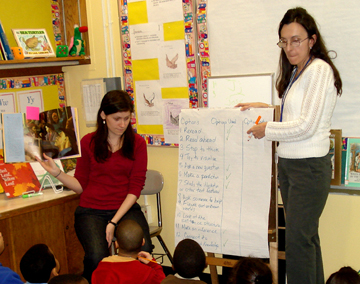|

This is photograph shows an example of the team teaching approach.
|
This lesson was field tested by third-grade teacher Carolyn Roby
and Pauline McVeigh, teacher-librarian. In the spring semester
2007, they served together at P.S. 88, The Little Sparrow School,
in the Bronx, New York.
Carolyn and Pauline team taught the entire lesson. This allowed
them to establish shared vocabulary and to jointly practice participation
signals that each would use in future lessons. They read part
of the book and modeled about choosing fix up options. Then they
read another part, and students listed the fix up options as an
entire group. Finally, they read the last part of the book, and
the students choose their own fix up options.
After leading the class in shared prewriting and a shared writing
draft, the educators monitored the students' individual reflective
paragraphs, which they took through the writing process.
Testimonial from Pauline: I thought [the lesson] was a huge success.
The collaboration proved not only to be successful for this project
but collaboration in general. I am new to the school and the teachers
have never used the library or LMS before. Two years ago the library
was in the hallway. Now I have the entire third grade collaborating
with me on their non-fiction units. I want to thank you for allowing
me this opportunity to show the school how worthwhile the library
can be.
|